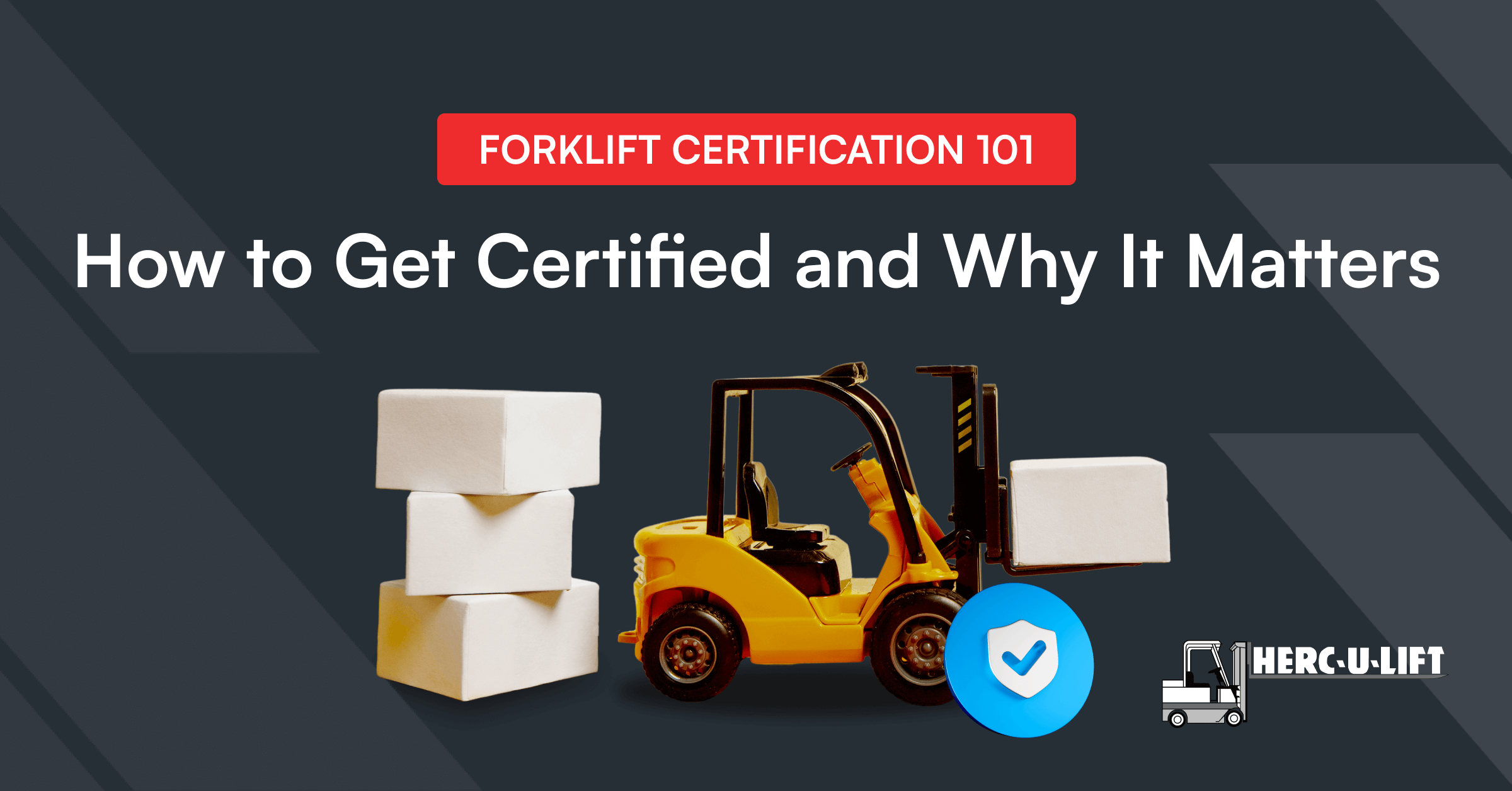Forklifts are the unsung heroes of busy job sites. You’ll spot them at warehouses, construction zones, or loading docks. They move loads with precision and speed. These machines make jobs easier and far more efficient.
But here’s the thing: forklifts aren’t toys. They’re powerful machines that weigh tons. One wrong move can cost you thousands of dollars in damage. In some cases, accidents may even cause injuries or fatalities.
That’s where forklift certification comes in. It serves as proof that an operator knows how to handle this heavy equipment safely, legally, and effectively.
As good old Uncle Ben would say: “With great power comes great responsibility.”
In this guide, we’ll break down everything you need to know about forklift certification. We’ll discuss what it is, why it matters, and how to get certified. We also tell you how much it costs and how long it lasts.
You may be a warehouse worker hoping to boost your job prospects. Or you may be an employer trying to stay compliant. At any rate, we’ve got you covered. By the end of this blog, you’ll know exactly what steps to take to get certified and stay safe on the job.
What Is Forklift Certification?
Forklift certification means a person has completed the required Occupational Safety and Health Administration (OSHA) training for safe forklift operation. The program includes classroom or online instruction, paired with hands-on training. The process ends with evaluations of both theory and operating ability. Once completed, it culminates in an official credential that proves a person has the knowledge and skills to operate forklifts.
Many workers also ask about forklift license requirements. However, OSHA doesn’t technically issue licenses. Instead, it requires certification through training. Certification is the official documentation showing an operator completed OSHA-compliant training.
Certification is important because it opens work opportunities and guarantees job safety. Furthermore, it is required by U.S. law under OSHA regulations. As such, it protects businesses from costly fines. Similar mandates are also implemented in different countries.
Why Forklift Certification Matters
Forklift certification isn’t optional for anyone who wants to work as an operator. It’s a legal, safety, and career requirement. Here’s why it’s a big deal:
Safety at Work
Every year, forklifts cause around 85 fatal accidents and 34,000 serious injuries in the U.S. alone. Most of these happen because of tip-overs, collisions, or improper use. About 70% of these accidents are preventable with proper training, according to OSHA.
Certification teaches operators:
- How to balance loads and perform inspections.
- Safe turning speeds (hint: forklifts aren’t racecars).
- How to handle uneven floors and ramps.
- What not to do (like lifting your buddy on the forks – yes, it happens).
Career Advancement
Certified operators enjoy better job opportunities. Most employers also provide some form of warehouse training alongside certification to get operators job-ready. Having that card in your wallet is like holding a golden ticket for certain jobs. It proves your competence as an operator and sets you apart in a competitive market.
Employer Benefits
It’s not just workers who gain from forklift certification. Employers win, too. Key advantages include:
- Fewer workplace accidents (which lowers insurance costs).
- Legal compliance with OSHA regulations (no fines breathing down your neck).
- A safer, more productive job site.
How to Get Forklift Certified (Step-by-Step)
Forklift certification is a straightforward process. The whole thing can be completed within 1 to 2 days.
Here’s how it works:
Step 1: Enroll in an OSHA-Compliant Training Program.
Choose an authorized training center. This could be an in-house program, a third-party provider, or even an accredited online course.
Step 2: Complete Classroom or Online Theory Training.
This part covers the “book smarts” of forklift operation. Topics covered include forklift operation basics, safety regulations, and maintenance checks. It usually takes a few hours to complete this.
Step 3: Hands-On Practical Training.
Next, you move from theory to practice. You get to actually drive a forklift! Under the supervision of a qualified trainer, you’ll learn how to:
- Start, steer, and stop safely.
- Pick up, transport, and set down loads.
- Maneuver in tight spaces.
- Handle tricky situations like ramps and loading docks.
Step 4: Pass Written and Practical Evaluation.
After that, you’ll need to pass a written test and a skills evaluation behind the wheel. Don’t worry! This isn’t like your high school math exam. As long as you’ve paid attention, you’ll do fine.
Step 5: Receive Your Certification Card
At the end of the process, you’ll be awarded your official forklift certification. It typically comes as a wallet-sized card or a full certificate, depending on the provider. Both list your name, training date, and the forklift class you’re qualified to operate.
Think of it as your ticket to legally and safely drive on the job. So, always keep it handy. You may be asked to show it at any time. And that’s it! You’re officially forklift certified.
Cost, Duration & Renewal
Now here’s what most people want to know: how much and how long?
Cost of Forklift Certification
You may have to pay around $100 to $300, depending on your provider and course type. Take note that online courses tend to be on the lower end. In-person or customized site training may be more expensive.
Also, remember that some companies pay for their employees’ training. Make sure to ask before shelling out your own money.
Program Duration
Most last between 1 to 2 days. Online courses offer greater flexibility. Some allow completion over several days. Hands-on training and evaluations might add some extra time.
Renewal Requirements
Forklift certification doesn’t last forever. In fact, OSHA requires recertification every 3 years. These refresher training requirements keep operators sharp and compliant.
• You’re involved in an accident.
• You’re caught demonstrating unsafe operation.
• You switch to a different type of forklift or heavy equipment.
Types of Forklift Certifications
OSHA categorizes forklifts into seven classes, namely:
- Class I: Electric Motor Rider Trucks (think warehouse workhorses).
- Class II: Narrow Aisle Trucks (used in tight warehouse spaces).
- Class III: Electric Hand Trucks and Pallet Jacks.
- Class IV: Internal Combustion Cushion Tire Trucks (indoor, smooth surfaces).
- Class V: Internal Combustion Pneumatic Tire Trucks (outdoor, rough surfaces).
- Class VI: Electric & IC Tractors (tuggers).
- Class VII: Rough Terrain Forklifts (construction sites, lumber yards).
Certification has to match the equipment. Being trained on a Class I forklift doesn’t mean you’re cleared to drive a rough terrain model.
Employer Responsibilities
Employers carry certain responsibilities under the OSHA law. They must:
• Ensure every forklift operator is trained and certified.
• Keep accurate records of operator certifications and training dates.
• Provide refresher training and evaluations when necessary.
Additionally, employers have to confirm that operators are properly certified for the machine they will use. This precision in certification enhances safety and operational effectiveness. If OSHA shows up and finds uncertified operators, it’s the employer who pays the fines.
Common FAQs
Yes for the classroom portion. But for the hands-on portion? No. OSHA requires on-site practical evaluation. You’ll need in-person training at some point.
Technically, no. Forklift certification is non-transferable. Each employer must certify operators according to their own site-specific conditions. However, many employers accept prior certification as proof of qualification. They may only require a refresher or site-specific training before hiring a certified operator with prior experience.
Employers can face $5,000 to over $15,000 fines per violation. Repeat offenses may even mean bigger fees.
Not usually, unless the employer requires it. Forklifts are operated on private property, not public roads.
Three years. After that, you’ll need to renew.
Conclusion
Forklift certification might seem like just another item on a long compliance checklist. It’s definitely way more than that. It’s about avoiding costly mistakes and making sure warehouses, construction sites, and factories run smoothly. Ultimately, it plays a critical role in preventing injuries and protecting lives.
Whether you’re new to forklifts or warehouse management, certification is a smart move with big payoffs. For workers, it means safer workdays. For employers, it means fewer accidents and reduced liability. You also enjoy peace of mind even when OSHA comes knocking on your door.
So yes, safety should always come first. Everyone benefits when you get the right forklift certification.
If you think it’s time to get certified or update your team’s training, don’t delay. Contact us about our safety training course.
Get that card in your pocket and operate forklifts the right way. After all, these machines are too powerful and too important to be left to chance.




